
When The Greatest, Muhammad Ali, came to my mohalla
“When his car came they started jogging alongside it.” 100 men in karate uniforms escorted Ali’s car to the gym.
Block 13 in Federal B Area is a settled neighbourhood, a place where the word neighbour still carries meaning. Part of the city’s district central, it became inhabited with people of my clan who first lived in Nizamabad and other places where Urdu speakers from India had formed their enclave. As the 70s started they moved from these places and built homes here creating a sort of “Little Amroha.”
I grew up there surrounded by folks at whose place you could drop in unannounced at lunch and be led straight to the table. Indeed, the general saying was that you could leave a child unattended on the streets and he would be retuned in a few hours cleaned, fed and even napping, such was the social network. Everyone knew each other in a way unimaginable now.
For instance Ishaq Bhai, the proprietor of a small laundromat who set up shop 40 years back, knows how much starch each customer likes in his kurtas and in his spare time would join the boys playing cricket in front of his shop. Block 13 or taira number had a relaxed air and the most thrilling thing its unassuming residents witnessed would be a neighbourhood wedding or the fireworks at Shab-e-Baraat.
But in October 1988 things were about to get very exciting. Unknown to anyone events were taking place that would bring Muhammad Ali, arguably the most famous man in the world, to the hood.
We all loved him, some for his sporting prowess but many because he was one of us, a Muslim who had given up the world title for his beliefs. Back when he was ostracised for being a draft dodger Zulfikar Ali Bhutto had invited him to live in Pakistan where he would be welcomed with open arms. PTV live broadcasted his 1974 fight against George Foreman a historic moment for the station which didn’t usually do satellite transmissions. The match started at 4:00 am and hundreds of thousands cheered when he knocked out Foreman in the 8th rounds.
My own connection with him really happened when digging around in the attic I chanced upon a dog eared copy of his autobiography The Greatest. My father had bought it years back and though the cover was torn and mildewed I treasured that copy. I knew about Ali, the whole world did, but reading his story in his own words made me realise just how special he was. He was a great boxer, arguably the greatest, but there were other names in boxing. Legends before him such as Jack Johnson the first black heavy weight champion and someone Ali idolised, Joe Louis who beat the Nazi propaganda of white supremacy when he put down Max Schmeling, Rocky Marciano who finished his career undefeated against whom Ali ‘fought’ in a computer rendering of fighters from different eras.
Then there were contemporaries: Joe Frazier, George Foreman, Floyd Patterson and many more, all very capable and legends in their own right. Ali fought against them and the matches stand out as among the best exhibitions of what 19th century British journalist and sportswriter Pierce Egan aptly called “the sweet science of boxing”. His three fights against Frazier are like three parts of a great play and an essential viewing for anyone remotely interested in pugilism.
Ali was a master tactician bringing nous and strategy into a sport that had often been characterised by sheer power and ferocity. He was strong, lithe and fast enough to recite poetry between punches. His jabs would be accompanied by a steady stream of taunts leaving the opponent and the referees flummoxed. The prefight noise, interviews with Howard Cosell and others, the poetry, predictions about which round he would win the match, there was so much to Ali that made him stand out from his opponents and in fact, the rest of the sporting world. He was equally at home in the ring pounding away at mob supported Sonny Liston or befriending Bertrand Russel while in London to fight the British champion Henry Cooper. Boxing’s rise and fall coincides with his career but Ali was not just a sportsperson, he transcended sport.
When he started professional boxing Ali was an electrifying anomaly, equally famous for his ring prowess and clever wordplay, good looks and overall chutzpah. As time went on, his ability to make good on his boasts and pre-fight predictions was shadowed by the new role of a conscientious objector, a principled Muslim and overall underdog who battled the US government in the Supreme Court of his right to refuse to take any action in Vietnam. The irrepressible, brash and “pretty” Ali who defeated Liston in 1964 to become champ, challenged America every chance he got and forced it to confront issues of race, religion, colour, patriotism and civil rights. Ultimately, he stood vindicated. The same government which was trying to jail him later awarded him the Presidential Medal of Freedom.
Even after Parkinson slowed and silenced him, the kid from Louisville, Kentucky, carried on with grace, lighting the torch with faltering hands at the Atlanta Olympics 1996 and named the Sportsman of Millennium. Ali showed us that he can take the blows of men and fate and remain proud and tall. Truly, The Greatest. And now the world’s most famous man was coming to the mohalla.
The reason for this momentous happening was because of a gym: Haji Club. In 1972 Haji Abdur Rehman opened a gym at the corner of Block 13, right next to the water pump station just off the Shahrah-e-Pakistan road. Haji Rehman had been active in wrestling pre-partition and had trained the likes of Gama Pahalwan. He believed that young Muslims should stay strong and pious, fighting off forces both the physical and incorporeal. When he came to Pakistan he opened a training centre in Pakistan Chowk where local wrestlers would train. His services for wrestling were recognised when the state and President Ayub Khan awarded him the Tamgha-e-Khidmat.
Soon after he decided that mere mass and a large body is not enough. He was inspired by Anotonio Inoki and extolled his charges to get a muscular physique like his. To enable this he bought four thousand square yards of land and opened Haji Club. The Club was initially free of charge so that people would join and then a monthly fee of Rs3 was introduced. Soon it became a mecca for aspiring bodybuilders all around Karachi. According to Abidur Rehman, the son of Haji Rehman, by the 80s Haji Club had grown to become the largest gym in the country.
That is when the Mr Asia Competition 1983-84 took place at Karachi’s Taj Mahal Hotel. The chief guest was Ahmet Enünlü the world champion Turkish bodybuilder, who in 1979 had won the overall amateur Mr Universe title of the National Amateur Body-Builders’ Association. The general secretary of the International Body Building Association was also in attendance and both went on a tour to inspect the local gyms. Seeing the overall size and number of machines both declared Haji Club as the largest in Asia and the label has stuck to this day.
Word about Haji Club’s pre-eminence reached Muhammad Ali through a person named Naseem Usmani who invited him for a visit, an invitation he immediately accepted. Usmani was active in sporting circles and when Ali visited Pakistan Usmani was part of the hosting party along with local boxing promoter Salim Sadiq. Seeing Ali’s enthusiasm Sadiq called Haji Rehman and told him that they would arrive in two hours. Mohammad Akhtar, Haji Rehman’s son-in-law recalls it well.
“We were completely taken back,” he said. “The evening karate classes had started when Haji Sahab announced the news to the people present. We scrambled to get things ready and in the meantime he told all the karate students to receive the car at Karimabad and personally escort it here. When his car came they started jogging alongside it and also guiding traffic. It started off with an entourage of a hundred or so but you can imagine the spectacle, a car surrounded by men in karate uniform running alongside a car. Soon word spread and the crowd around his car grew to thousands.”
Meanwhile, there was ordered pandemonium in the neighbourhood. Haji Rehman’s team was busy arranging chairs and mikes but the residents were getting wild with excitement. Muhammad Ali is coming! That was the refrain on everyone’s lips and the news spread far and fast. There was no social media or pervasive media coverage but from house to house, person to person, using telephone or just yelling, the visit was being broadcasted to everyone. The mosque’s muezzin announced it from minarets and kids ran screaming “Ali aya” in streets. Females were lined up on roofs and elderly men were climbing the club walls to catch a glimpse. In my own home Abba left dinner abruptly and grabbing us kids he made his way to the club which was just around the bend from my house.
Around 8:00pm Ali’s car was seen and the crowd erupted. If it wasn’t for the bodybuilders who were doing crowd control the car would have been swamped. It was eventually led from the back gate into the open space where the karate classes were held. After a quick tour and some speeches he was led to the mike. Aktar remembers his speech well,
“He said you are strong but real strength comes from Allah. I called myself greatest but only Allah is greatest. Trust only him and you will get even stronger.”
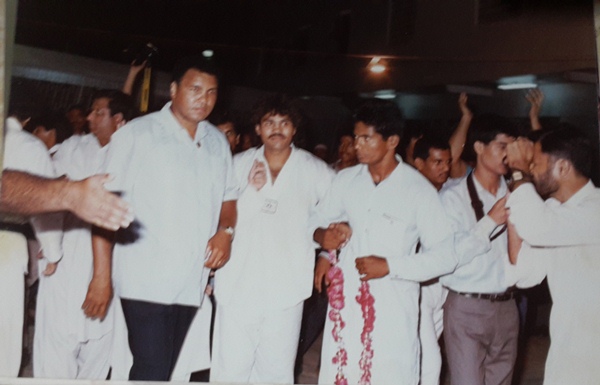 If it wasn’t for the bodybuilders who were doing crowd control the car would have been swamped.
If it wasn’t for the bodybuilders who were doing crowd control the car would have been swamped.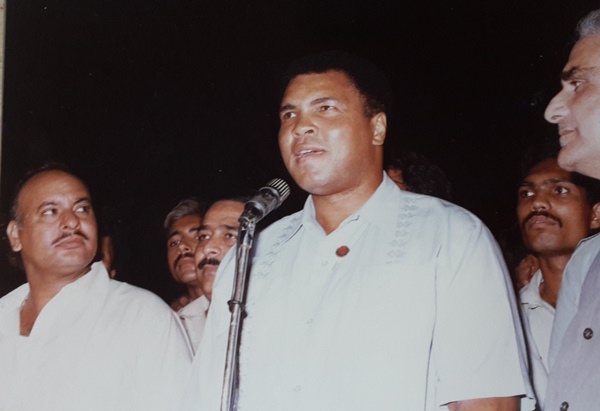 After a quick tour and some speeches he was led to the mike.
After a quick tour and some speeches he was led to the mike.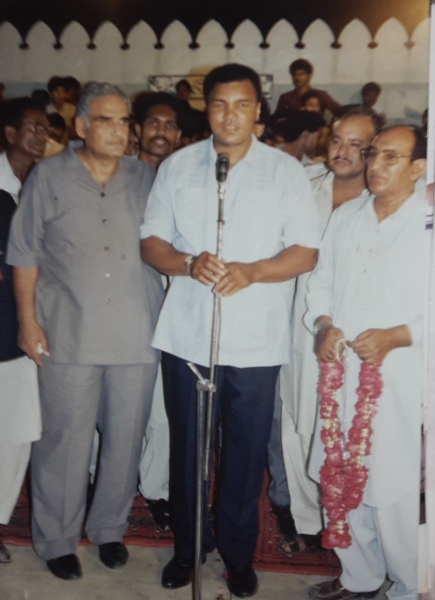 Ali flanked by Haji Rehman (left) and Salim Sadiq (right)
Ali flanked by Haji Rehman (left) and Salim Sadiq (right) Everyone wanted to touch him and get a picture taken even though getting close to him was a herculean task.
Everyone wanted to touch him and get a picture taken even though getting close to him was a herculean task.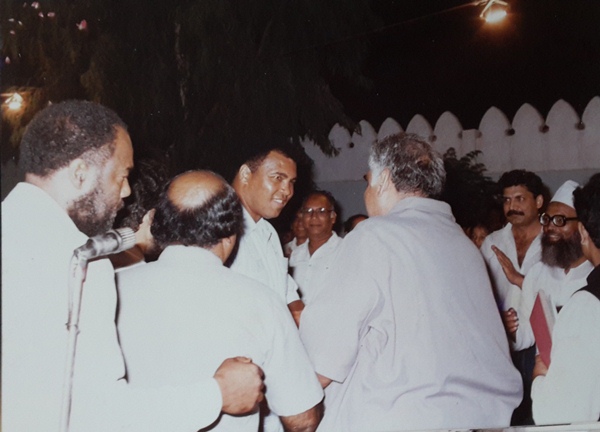 Ali met by Salim Sadiq and others.
Ali met by Salim Sadiq and others.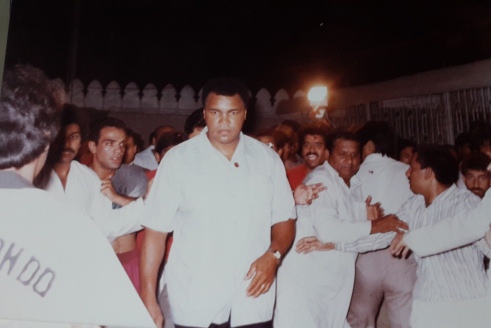 Entering the Club
Entering the Club The Crowd. Notice the man on the wall at extreme right.
The Crowd. Notice the man on the wall at extreme right.Everyone wanted to touch him and get a picture taken even though getting close to him was a herculean task. One man was in a hospital nearby. He was a heart patient but when he got to know that Ali was there, he begged his doctor to release him. The doctor finally agreed and he literally ran over, risking his life. When Ali found out he specially called him and hugged him but also told him not to take such risks. He bore the crush of people with grace. As Akhtar said,
“Through it all he kept smiling and each person who got close enough got a handshake with both hands. Another person would have been in a hurry to get away but he was very gracious. I remember his hands, large enough to engulf mine and felt sorry for the people who had been punched by those fists. He stood tall, like a colossus towering over the body builders and looked strong enough to take on anyone. At that time he did not suffer from Parkinson and was clear in speech and even threw a few fast punches at which the crowd roared.”
After two hours Ali said goodbye. The crowd for loath to let him go and roads had to be cleared for him to leave. As he waved goodbye from the car some people started running alongside trying to catch the last moments with him. One enthusiast ran all the way to Liaqatabad, some five km till the car stopped and Ali formally requested leave. As for me, I didn’t get the chance to personally meet him, the crowd was far too thick. I remember crying but my father consoled me that I should be happy just to be in his vicinity. The Greatest had come to my mohalla and his memory would live on forever. That was enough he told me. He was right.
All photos: Sibtain Naqvi




COMMENTS (3)
I have read a lot about Great Muhammad Ali and watched every video posted on YouTube. This article was amazing and new for me. I could also see some rare photographs. Thanks for such a fantastic article.
Comments are moderated and generally will be posted if they are on-topic and not abusive.
For more information, please see our Comments FAQ